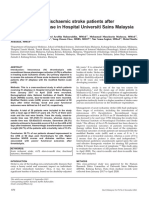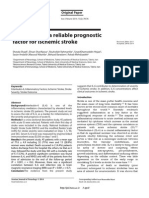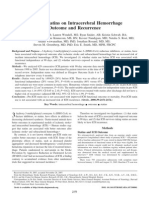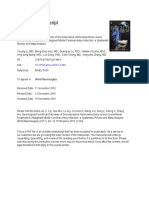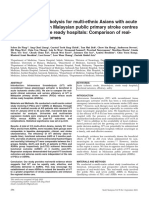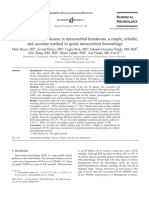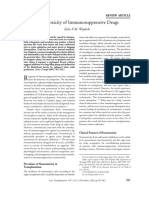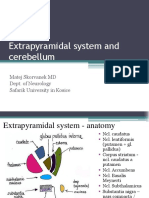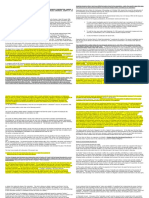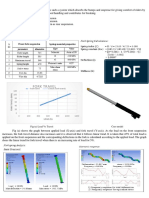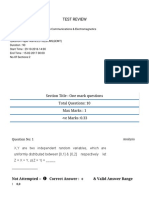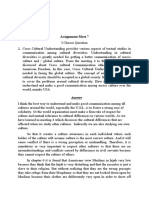Using The National Institutes of Health Stroke Scale (NIHSS) To Predict The Mortality and Outcome of Patients With Intracerebral Haemorrhage
Using The National Institutes of Health Stroke Scale (NIHSS) To Predict The Mortality and Outcome of Patients With Intracerebral Haemorrhage
Uploaded by
DanielMahendraCopyright:
Available Formats
Using The National Institutes of Health Stroke Scale (NIHSS) To Predict The Mortality and Outcome of Patients With Intracerebral Haemorrhage
Using The National Institutes of Health Stroke Scale (NIHSS) To Predict The Mortality and Outcome of Patients With Intracerebral Haemorrhage
Uploaded by
DanielMahendraOriginal Title
Copyright
Available Formats
Share this document
Did you find this document useful?
Is this content inappropriate?
Copyright:
Available Formats
Using The National Institutes of Health Stroke Scale (NIHSS) To Predict The Mortality and Outcome of Patients With Intracerebral Haemorrhage
Using The National Institutes of Health Stroke Scale (NIHSS) To Predict The Mortality and Outcome of Patients With Intracerebral Haemorrhage
Uploaded by
DanielMahendraCopyright:
Available Formats
Using the National Institutes of Health Stroke Scale
O R I G I N A L
A R T I C L E (NIHSS) to predict the mortality and outcome of
patients with intracerebral haemorrhage
CME
CM Cheung 張春明
TH Tsoi 蔡德康 Objectives To investigate whether the National Institutes of Health
Sonny FK Hon 韓方光 Stroke Scale (NIHSS) can be used to predict mortality and
M Au-Yeung 歐陽敏 functional outcome in patients presenting with intracerebral
KL Shiu 邵家樂 haemorrhage.
CN Lee 李至南 Design Retrospective study of a prospectively collected cohort.
CY Huang 黃震遐 Setting Regional hospital, Hong Kong.
Patients A cohort of 359 patients presented to our hospital from 1996 to
2001 with their first-ever stroke and intracerebral haemorrhage.
Main outcome measures The sensitivity and specificity of the NIHSS with a cut-off point of
20 in predicting mortality at 30 days and 5 years, and a favourable
functional outcome at 5 years.
Results A total of 359 patients were available for analysis and were
divided into three subgroups according to the site and the size
of the haematoma. The NIHSS can predict 30-day mortality with
a sensitivity of 81% and a specificity of 90%. The NIHSS can
predict 5-year mortality with a sensitivity of 57% and a specificity
of 92%. In predicting favourable functional outcomes at 5 years,
the NIHSS had a sensitivity of 98% and a specificity of 16%.
Conclusions The NIHSS performed on admission can be used to predict
mortality at 30 days and 5 years as well as favourable functional
outcome at 5 years, all with an acceptable sensitivity and
specificity.
Introduction
Intracerebral haemorrhage (ICH) is a major cause of stroke among Asians. It contributes to
about 10 to 15% of strokes in western countries.1 In Hong Kong, ICH contributes to about
30% of all strokes.2,3 The disease differs from ischaemic stroke, as it confers higher early
mortality and poorer long-term outcomes.4 A method of predicting mortality within 30
days and good long-term functional outcomes could facilitate interviews with patients and
their relatives in terms of decisions for invasive and/or supportive care. For this purpose,
complicated scoring systems had been created but were difficult to use in daily clinical
practice. In the recent 6 years, two less complicated scoring systems have been published.5,6
The ICH score involves a scoring system consisting of the Glasgow Coma Scale (GCS), age,
Key words infratentorial origin, ICH volume, and presence of intraventricular haemorrhage. The new
Cerebral hemorrhage; Outcome
assessment (health care); Predictive ICH score uses National Institutes of Health Stroke Scale (NIHSS), admission temperature,
value of tests; Sensitivity and specificity pulse pressure, presence of intraventricular haemorrhage, and subarachnoid extension of
haemorrhage. Whilst these scores are useful for clinical trials and sophisticated research,
Hong Kong Med J 2008;14:367-70 a system based on commonly assessed clinical parameters for stroke patients could be
much more useful. The NIHSS score is commonly obtained in patients presenting with
Department of Medicine, Pamela Youde acute stroke. It consists of 15 items and a total score of 42 points. A score of 0 indicates
Nethersole Eastern Hospital, Chai Wan, no clinically relevant neurological abnormality. If a patient scores more than 20, it usually
Hong Kong
CM Cheung, MRCP, FHKAM (Medicine)
indicates a dense paralysis with impaired consciousness. We studied whether the NIHSS
TH Tsoi, FRCP, FHKAM (Medicine) can provide adequate predictive information in the course of routine clinical practice.
SFK Hon, MRCP, FHKAM (Medicine)
M Au-Yeung, MRCP, FHKAM (Medicine)
KL Shiu, MRCP, FHKAM (Medicine)
CN Lee, MRCP
Methods
CY Huang, FRACP, FHKAM (Medicine)
In our hospital, all patients with acute stroke attending the Accident and Emergency
Correspondence to: Dr CM Cheung Department are admitted to the Medical Department. On admission, a stroke is defined
E-mail: chun-ming@graduate.hku.hk as acute if the onset of symptoms has ensued within 5 days. Patients are transferred to the
Hong Kong Med J Vol 14 No 5 # October 2008 # www.hkmj.org 367
# Cheung et al #
had been used prospectively by trained or certified
應用美國國家衛生研究院腦中風評估量表預 doctors to assess stroke patients within 2 days of
admission.
測腦出血病人的死亡率和康復效益
Patient data in the registry, in-patient hospital
目的 探討美國國家衛生研究院腦中風評估量表(NIHSS)能 records, out-patient follow-up notes, and subsequent
否用於預測腦出血病人的死亡率和康復效益。 hospital admission records were retrieved and
設計 對前瞻性收集數據的組群進行回顧研究。 retrospectively reviewed at 5 years or more after the
index stroke episode. For patients followed up in other
安排 香港一所地區醫院。 hospitals, their electronic hospital records, including
患者 1996至2001年,本醫院接收的359名首次中風兼腦出 discharge summary and out-patient progress notes,
血病人。 were traced. Patients were followed up in the
主要結果測量 以20為界點,應用NIHSS預測在第30天和第5年死亡 integrated clinics of our hospital and government
率,以及在第5年的康復效益情況的敏感度和特異性。 out-patient clinics. The patients could also have
been followed up by doctors in the rehabilitation
結果 本研究把359位病人按出血的位置和規模劃分為三
hospital, and sometimes in other hospitals (when
組作分析。NIHSS對預測第30天死亡率的敏感度為
they changed their residence). The modified Rankin
81%、特異性90%;NIHSS對預測第5年死亡率的敏感
score was estimated at 5 years, by using all of the
度為57%、特異性92%;NIHSS對預測第5年康復效益
written information collected in the medical record
情況的敏感度為98%、特異性16%。
and in the electronic record. We did not estimate the
結論 在病人進院時可應用NIHSS預測第30天和第5年的死 score before admission, so we cannot exclude other
亡率、以及第5年的康復效益情況,其敏感度和特異 factors affecting the score, eg chronic obstructive
性均在可接受的水平。 pulmonary disease. However, such factors were
not common in our cohort. Accurate classification
into five grades may be difficult but classification
into favourable outcome (a score of 0 to 2) or poor
neurosurgical team, only if neurosurgery is deemed outcome (a score of 3 to 5) appeared reasonable. We
necessary. From July 1996 onwards, all acute stroke usually described whether a patient could walk or
patients under the care of our department were was dependent for the activities of daily living during
assessed by the neurology team. We entered the data out-patient visits or admissions. The patients were
of all acute stroke patients into a stroke registry. This divided into three groups according to the size and
included: demographic data, risk factors for stroke, site of their haematoma. If the size of the haematoma
and stroke type (ischaemic, ICH, subarachnoid was estimated as more than 62.5 cm3, it was classified
haemorrhage). Non-contrast computed tomography as massive. Haematomas smaller than 62.5 cm3 were
of the brain was performed on all acute stroke classified into lobar (if within the brain parenchyma)
patients within 24 hours after admission, and the site or non-lobar (if in a deep part of the brain).
and the size of any haematoma recorded. All patients, The data were analysed by the Chi squared
who were enrolled in the first 5 years of our stroke test, if appropriate (using the Statistical Package for
registry with first-ever strokes and also diagnosed as the Social Sciences, Windows version 12.1; SPSS Inc,
having ICH, were identified for recruitment into the Chicago [IL], US). A P value of <0.05 (2-sided) was
present study. From 1997, in our institution the NIHSS taken to be statistically significant.
TABLE 1. Baseline demographic and clinical characteristics of the whole cohort and different types of intracerebral haemorrhage (ICH)
Characteristic Whole cohort Patients with small Patients with lobar Patients with
(n=359) non-lobar ICH (n=239) ICH (n=68) massive ICH (n=52)
Mean (range) age (years) 71.4 (27-98) 69.9 74.1 74.4
Male:female 192:167 141:98 28:40 23:29
No. (%) of patients with atrial fibrillation 15 (4) 13 (5) 1 (1) 1 (2)
No. (%) of patients with diabetes mellitus 66 (18) 49 (21) 8 (12) 9 (17)
No. (%) of patients with hypertension 201 (56) 144 (60) 31 (46) 26 (50)
No. (%) of patients with ischaemic heart disease 21 (6) 13 (5) 3 (4) 5 (10)
No. (%) of patients with hypercholesterolaemia 28 (8) 22 (9) 4 (6) 2 (4)
No. (%) of smokers 66 (18) 52 (22) 9 (13) 5 (10)
Mean NIHSS* score 16 13 17 32
* NIHSS denotes National Institutes of Health Stroke Scale
368 Hong Kong Med J Vol 14 No 5 # October 2008 # www.hkmj.org
# National Institutes of Health Stroke Scale #
Results TABLE 2. The 30-day and 5-year mortality and favourable functional outcome rates at 5
years related to NIHSS assessments on admission*
A total of 431 patients suffering from first-ever stroke
NIHSS No. (%)
and diagnosed as having had cerebral haemorrhage
were enrolled in our stroke registry during the 5-year 30-Day mortality 5-Year mortality Favourable 5-year functional
outcome for survivors†
period from 28 July 1996 to 27 July 2001. The outcome
of 24 first-ever ICH patients could not be traced at >20 96/120 (80) 106/120 (88) 2/24 (8)
the time of review. The remaining 407 patients were 11-20 15/61 (25) 35/61 (57) 9/46 (20)
included in this analysis. Among these 407 patients, 6-10 3/56 (5) 14/56 (25) 17/53 (32)
only 359 patients had NIHSS assessments on the day 0-5 5/122 (4) 31/122 (25) 73/117 (62)
of admission.
* NIHSS denotes National Institutes of Health Stroke Scale
The baseline characteristics of these 359 † P<0.0001 when using 0-20 vs >20 for 30-day, 5-year mortality and good outcome
patients are shown in Table 1. The relationships
between NIHSS assessments on admission and 30-
day mortality, 5-year mortality, and the favourable TABLE 3. The 30-day mortality and favourable functional outcome rates at 5 years for
subgroups with massive, lobar, and non-lobar (small) intracerebral haemorrhage (ICH)
functional outcome at 5 years for the whole cohort are
shown in Table 2. The corresponding relationships for NIHSS* in various No. (%)
subgroups
the three different ICH subgroups are shown in Table 30-Day mortality Favourable 5-year functional
3. Except for the massive ICH subgroup (in which outcome for survivors
there were too few 30-day survivors), the relationship Massive ICH †
between NIHSS assessments on admission and 30- >20 38/40 (95) 0/2 (0)
day mortality or 5-year functional outcome holds true 0-20 5/12 (42) 2/7 (29)
for all subgroups.
Lobar ICH
‡
Age did not affect the poor outcome of those
>20 18/25 (72) 0/17 (0)
with NIHSS scores of higher than 20. However, among
0-20 5/44 (11) 14/39 (36)
those with scores of less than 20, younger patients
survived better (Table 4). Compared to older patients, Small non-lobar ICH §
those who were younger also had better 5-year >20 40/55 (73) 2/15 (13)
functional outcomes regardless of NIHSS category 0-20 13/183 (7) 83/170 (49)
(Table 5). In all, 41 patients had a second stroke after
* NIHSS denotes National Institutes of Health Stroke Scale
surviving the first 30 days. Adjustment of the results † P<0.0001 when using 0-20 vs >20 for 30-day mortality, P=1 for functional outcome
to their modified Rankin scores just before their ‡ P<0.0001 when using 0-20 vs >20 for mortality and P<0.01 for good outcome
second stroke shows that there would have been § P<0.02 for both mortality and good outcome
80 favourable outcomes for those with initial NIHSS
scores of 0-5, and 19 such outcomes for those with TABLE 4. The 30-day mortality for different age-groups
scores of 6-10. This would have further improved
NIHSS* No. (%)
the overall outcome of the whole cohort with NIHSS
scores of <20 (108 favourable outcomes instead of 99), <60 Years ≥60 Years
and accentuated the disparity of outcomes between >20 †
13/16 (81) 83/104 (80)
those with NIHSS scores of >20 and <20. By itself, age 0-20 1/56 (2) 22/183 (12)
did not increase the risk of recurrent stroke over 5
* NIHSS denotes National Institutes of Health Stroke Scale
years (in the group aged <60 years, the rate was 15%; † P>0.05 for NIHSS>20; P<0.05 for NIHSS≤20
and in those aged ≥60 years, it was 10%). Recurrent
stroke therefore was not the cause of less favourable
functional outcomes in older patients. TABLE 5. Favourable functional outcomes at 5 years for different
age-groups
In total, 186 patients died during the study
period, 119 within 30 days, and 67 between 30 days and NIHSS* No. (%)
5 years. The number of patients who died of vascular <60 Years ≥60 Years
causes (ie not counting aspiration pneumonia) was >20† 2/16 (13) 0/104 (0)
35. 0-20 43/56 (77) 56/183 (31)
* NIHSS denotes National Institutes of Health Stroke Scale
Discussion †
P<0.05 when comparing two age-groups for favourable functional
outcome in different NIHSS
This study was hospital-based. Therefore patients
with very minor deficits (not hospitalised whatever
the reason), those who refused admission, those with our cohort.
severe deficits who died before admission, and those When the NIHSS is used to predict 30-day
admitted to private hospitals were not included in mortality, it has good sensitivity (81%) and specificity
Hong Kong Med J Vol 14 No 5 # October 2008 # www.hkmj.org 369
# Cheung et al #
(90%) using a cut-off point of 20 (0-20 vs >20). Using Furthermore, the ICH scores have not
the same cut-off point to predict 5-year mortality, previously been studied in terms of predicting long-
the NIHSS has a lower sensitivity (57%) but good term prognosis; only outcome at 30 or 100 days has
specificity (92%). When using an NIHSS cut-off point been reported.5-7 For predicting favourable outcome
of ≤20 to predict a good outcome among survivors from stroke onset at 5 years, the NIHSS alone already
at 5 years, its sensitivity was 98% but specificity was achieved an acceptable negative predictive value.
16%. If the cut-off point is changed from 20 to 5 (0-5 This information is important as the busy clinician can
vs >5), sensitivity was reduced to 72% but specificity interview relatives in terms of life-support decisions;
increased to 68%. When the NIHSS is used to predict a score of >20 means a high chance of death in 30
30-day mortality, it has good sensitivity (81%) and days and virtually no chance of favourable long-term
specificity (90%) using a cut-off point of 20 (0-20 vs recovery, even in patients surviving 30 days. In which
>20). Using the same cut-off point to predict 5-year case, statistically the chance the patient would die
mortality, the NIHSS has a lower sensitivity (57%) but within 30 days would be 80%, and within 5 years it
good specificity (92%). When using an NIHSS cut- would be 88%. The chance of a poor outcome at 5
off point of ≤20 to predict a good outcome among years from the stroke onset would be 98%.
survivors at 5 years, its sensitivity was 98% but Taking age into consideration did not affect the
specificity was 16%. If the cut-off point is changed predictive value of a high NIHSS on 30-day mortality.
from 20 to 5 (0-5 vs >5), sensitivity was reduced to 72% However, chronological age may reflect concomitant
but specificity increased to 68%. disease burden, and less favourable response to the
In two earlier studies which have examined the neurological insult. Compared with persons aged 60
impact of NIHSS on outcome in cerebral haemorrhage, to 80 years, younger patients with an NIHSS score of
Cheung and Zou6 found that the NIHSS assessment ≤20 had a lower 30-day mortality rate (2% vs 12%),
but not the GCS was an independent predictor of which was statistically significant (P<0.05, Table 4). In
mortality and outcome at 30 days. A study published predicting favourable functional outcomes among
in 2006 also used the NIHSS to predict outcome those with an NIHSS score of ≤20, younger patients
at 100 days, when the patients were assessed at (<60 years) also faired better, although this did not
admission.7 The investigators assigned scores for: detract from the adverse prognosis of a high score on
NIHSS assessments (0-5=0; 6-10=1; 11-15=2; 16-20=3; functional outcome (Table 5).
>20=4), the level of consciousness (alert=0; drowsy=1; In conclusion, NIHSS assessments performed
stuporous=2; comatose=3), and age (<60=0; 60-69=1; at admission can be used to predict the 30-day
70-79=2; ≥80=3). Using a total score cut-off point of <3 and 5-year mortality as well as long-term outcome
to predict complete recovery and >7 to predict death, among survivors. Irrespective of age or type of
yielded a sensitivity of 74% and specificity of 84% for the cerebral haemorrhage, an NIHSS score of >20
the former and corresponding figures for the latter is a strong predictor of death or poor functional
were 44% and 98%. outcome. Whilst additional information, such as
Compared to previous scoring systems, the age, precise location and size of the haemorrhage,
NIHSS alone is much simpler to use. A cut-off point at intraventricular and subarachnoid extension,
0-20 versus >20 already achieved sufficient sensitivity temperature and blood pressure may improve
and specificity for predicting 30-day mortality, close prognostic precision, the busy clinician may find
to what was reported for the original, modified and the NIHSS sufficient for most clinical management
Essen ICH scores. decisions and counselling.
References
1. Caplan LR. Intracerebral haemorrhage. Lancet 1992;339: Johnston SC. The ICH score: a simple, reliable grading scale
656-8. for intracerebral hemorrhage. Stroke 2001;32:891-7.
2. Huang CY, Chan FL, Yu YL, Woo E, Chin D. Cerebrovascular 6. Cheung RT, Zou LY. Use of the original, modified, or
disease in Hong Kong Chinese. Stroke 1990;21:230-5. new intracerebral hemorrhage score to predict mortality
3. Kay R, Woo J, Kreel L, Wong HY, Teah R, Nicholls MG. and morbidity after intracerebral hemorrhage. Stroke
Stroke subtypes among Chinese living in Hong Kong: the 2003;34:1717-22.
Shatin Stroke Registry. Neurology 1992;42:985-7. 7. Weimar C, Benemann J, Diener HC; German Stroke Study
4. Cheung CM, Tsoi TH, Hon SF, et al. Outcomes after first- Collaboration. Development and validation of the Essen
ever stroke. Hong Kong Med J 2007;13:95-9. Intracerebral Haemorrhage Score. J Neurol Neurosurg
5. Hemphill JC 3rd, Bonovich DC, Besmertis L, Manley GT, Psychiatry 2006;77:601-5.
370 Hong Kong Med J Vol 14 No 5 # October 2008 # www.hkmj.org
You might also like
- NIHSS Scoring: Coma Difficult or Confused TipsDocument1 pageNIHSS Scoring: Coma Difficult or Confused TipsDanielMahendra100% (1)
- Benefits of Assessing The Solids Production Risk in A North Sea ReservoirDocument9 pagesBenefits of Assessing The Solids Production Risk in A North Sea Reservoirredup25No ratings yet
- Cerebral Herniation Syndromes and Intracranial HypertensionFrom EverandCerebral Herniation Syndromes and Intracranial HypertensionMatthew KoenigNo ratings yet
- Antonis M.Koltsidas - Greek Education in Monastir - PelagoniaDocument256 pagesAntonis M.Koltsidas - Greek Education in Monastir - Pelagoniavaler_crushuveanlu67% (3)
- 347 In-Hospital Functional Outcome After Acute Ischemic StrokeDocument4 pages347 In-Hospital Functional Outcome After Acute Ischemic StrokeIda Ayu Trisna DewiNo ratings yet
- Comparison of Prognostic Scores For ICHDocument6 pagesComparison of Prognostic Scores For ICHadilNo ratings yet
- 50-File Utama Naskah-54-1-10-20200928 PDFDocument9 pages50-File Utama Naskah-54-1-10-20200928 PDFrifki irsyadNo ratings yet
- Comparison OF Helsinki CT AND Rotterdam CT Scoring Systems AS Prognostic Factors of Brain InjuryDocument11 pagesComparison OF Helsinki CT AND Rotterdam CT Scoring Systems AS Prognostic Factors of Brain Injuryncbandung1971No ratings yet
- Predicting 30-Day Case Fatality of Primary Inoperable Intracerebral Hemorrhage Based On Findings at The Emergency DepartmentDocument6 pagesPredicting 30-Day Case Fatality of Primary Inoperable Intracerebral Hemorrhage Based On Findings at The Emergency DepartmentNouchan NoupNo ratings yet
- Pocusj 08 16563Document5 pagesPocusj 08 16563andres ruizNo ratings yet
- Acute Stroke ThrombolysisDocument5 pagesAcute Stroke ThrombolysisTingksNo ratings yet
- 11mqx9mDocument8 pages11mqx9mUmar FarooqueNo ratings yet
- (Acta Facultatis Medicae Naissensis) Surgical Outcome in Patients With Spontaneous Supratentorial Intracerebral HemorrhageDocument9 pages(Acta Facultatis Medicae Naissensis) Surgical Outcome in Patients With Spontaneous Supratentorial Intracerebral HemorrhageAstri AmaliaNo ratings yet
- The Effect of Time On Cognitive Impairments After Non Traumatic Subarachnoid Haemorrhage and After Traumatic Brain InjuryDocument13 pagesThe Effect of Time On Cognitive Impairments After Non Traumatic Subarachnoid Haemorrhage and After Traumatic Brain InjuryReyhansyah RachmadhyanNo ratings yet
- Clinical Course of Untreated Cerebral Cavernous MalformationsDocument8 pagesClinical Course of Untreated Cerebral Cavernous MalformationsMalaspulgasNo ratings yet
- SICH MGMTDocument12 pagesSICH MGMTLennon Ponta-oyNo ratings yet
- KazaryanDocument9 pagesKazaryantahaNo ratings yet
- Prediction of Minimally Conscious State With Brain Stem Reflexes in Unconscious Patients After Traumatic Brain InjuryDocument5 pagesPrediction of Minimally Conscious State With Brain Stem Reflexes in Unconscious Patients After Traumatic Brain InjuryMARIANA LINETH OROZCO RICARDONo ratings yet
- J Neurosurg Pediatr Article p595Document7 pagesJ Neurosurg Pediatr Article p595iagosimon05No ratings yet
- Life 13 00846Document14 pagesLife 13 00846Anonymous tG35SYROzENo ratings yet
- Consoli Et Al 2023 Unfavorable Clinical Outcomes in Patients With Good Collateral Scores Following EndovascularDocument10 pagesConsoli Et Al 2023 Unfavorable Clinical Outcomes in Patients With Good Collateral Scores Following EndovascularZysha MalinaNo ratings yet
- Stroke Outcome Alteplase USMDocument6 pagesStroke Outcome Alteplase USMTingksNo ratings yet
- Trial of Decompressive Craniectomy For Traumatic Intracranial HypertensionDocument12 pagesTrial of Decompressive Craniectomy For Traumatic Intracranial HypertensionV ANo ratings yet
- Final Synopsis 1Document18 pagesFinal Synopsis 1Satyam KumarNo ratings yet
- Chen 2021Document7 pagesChen 2021Felipe GonzálezNo ratings yet
- IL 6 and StrokeDocument7 pagesIL 6 and StrokeDian Laras SuminarNo ratings yet
- Relationship of National Institutes of Health Stroke Scale To 30-Day Mortality in Medicare Beneficiaries With Acute Ischemic StrokeDocument10 pagesRelationship of National Institutes of Health Stroke Scale To 30-Day Mortality in Medicare Beneficiaries With Acute Ischemic StrokePutri NurdiyantiNo ratings yet
- Comparison of Neurological Clinical Manifestation in Patients With Hemorrhagic and Ischemic StrokeDocument5 pagesComparison of Neurological Clinical Manifestation in Patients With Hemorrhagic and Ischemic StrokeDessy FarwasNo ratings yet
- Putra,+11 Bmj.v5i1.163 PDFDocument4 pagesPutra,+11 Bmj.v5i1.163 PDFrifki irsyadNo ratings yet
- Prediction of Functional Outcome in Patients With Primary Intracerebral HemorrhageDocument7 pagesPrediction of Functional Outcome in Patients With Primary Intracerebral HemorrhageAinun RamadaniNo ratings yet
- Siriraj Scale ScoreDocument6 pagesSiriraj Scale ScoreIhsan Nur MahmudiNo ratings yet
- Acute Ischemic Stroke NIHSS ScoreDocument7 pagesAcute Ischemic Stroke NIHSS ScoreJaneeta AssaqeeraNo ratings yet
- F K Korley Et Al Prognostic Value of Day of Injury Plasma GFAP and UCHL1 Concentrations - Valor PronósticoDocument11 pagesF K Korley Et Al Prognostic Value of Day of Injury Plasma GFAP and UCHL1 Concentrations - Valor Pronósticoapineda.spsNo ratings yet
- 1-s2.0-S1474442224004253-mainDocument9 pages1-s2.0-S1474442224004253-mainFamilia PipekNo ratings yet
- Glyceryl Trinitrate For Acute Intracerebral HemorrhageDocument21 pagesGlyceryl Trinitrate For Acute Intracerebral HemorrhageAhmad Al-atthosNo ratings yet
- KJN 12 47Document8 pagesKJN 12 47Khenza Nur HasanahNo ratings yet
- Efecto de Estatinas en RecurrencaDocument4 pagesEfecto de Estatinas en RecurrencaLeonela Ramirez Almanza y Lina Maria Ossa HerreraNo ratings yet
- Yu SIFDocument8 pagesYu SIFAhmed AyazNo ratings yet
- Hemphill Et Al 2001 The Ich ScoreDocument7 pagesHemphill Et Al 2001 The Ich ScoreMuhammad Sibtain NisarNo ratings yet
- NIH Public Access: Predictors of Positive Head CT Scan and Neurosurgical Procedures After Minor Head TraumaDocument13 pagesNIH Public Access: Predictors of Positive Head CT Scan and Neurosurgical Procedures After Minor Head TraumadenisNo ratings yet
- Stoke N Quality LifeDocument8 pagesStoke N Quality LifeHasvianNo ratings yet
- CCMP96 RD 039+腦中風之中醫證型就主流醫學觀點之研究 (2 1)Document24 pagesCCMP96 RD 039+腦中風之中醫證型就主流醫學觀點之研究 (2 1)陳瑋毅No ratings yet
- Craniectomia DescompresivaDocument51 pagesCraniectomia DescompresivaVlady78No ratings yet
- Nottingham Hip Fracture Score As A PredictorDocument4 pagesNottingham Hip Fracture Score As A PredictorRENAULTNo ratings yet
- 01 STR 32 1 63Document7 pages01 STR 32 1 63Pasca Anrinanto HilalNo ratings yet
- MainDocument4 pagesMainAnis LovykaNo ratings yet
- Main 70Document7 pagesMain 70pokharelriwaj82No ratings yet
- Research Article: Retinal Structural and Microvascular Alterations in Different Acute Ischemic Stroke SubtypesDocument10 pagesResearch Article: Retinal Structural and Microvascular Alterations in Different Acute Ischemic Stroke SubtypesKarina NathaniaNo ratings yet
- Jurnal 16Document3 pagesJurnal 16Zella ZakyaNo ratings yet
- The ICH Score: A Simple, Reliable Grading Scale For Intracerebral HemorrhageDocument8 pagesThe ICH Score: A Simple, Reliable Grading Scale For Intracerebral HemorrhageAnonymous vwi2Fc2BINo ratings yet
- Predicted Unfavorable Neurologic Outcome Is Overestimated by the Marshall Computed Tomography Score, Corticosteroid Randomization After Significant Head Injury (CRASH), and International Mission for Prognosis and Analysis of Clinical TrialsDocument5 pagesPredicted Unfavorable Neurologic Outcome Is Overestimated by the Marshall Computed Tomography Score, Corticosteroid Randomization After Significant Head Injury (CRASH), and International Mission for Prognosis and Analysis of Clinical Trialsvinicius.farahNo ratings yet
- Marshall1991 The Outcome of Severe Closed Head InjuryDocument9 pagesMarshall1991 The Outcome of Severe Closed Head InjuryJulieta PereyraNo ratings yet
- Acute Ischaemia StrokeDocument8 pagesAcute Ischaemia StrokeSangeetha VijianNo ratings yet
- RadioDocument4 pagesRadiomuhammad robyNo ratings yet
- Clinical and Radiographic Predictors of Intracerebral Hemorrhage OutcomeDocument19 pagesClinical and Radiographic Predictors of Intracerebral Hemorrhage OutcomeAndre DharmawanNo ratings yet
- Fneur 11 00517Document9 pagesFneur 11 00517hardi adiyatmaNo ratings yet
- 081_EIJ-D-23-00312_Werner_229Document13 pages081_EIJ-D-23-00312_Werner_229Bambang DwiputraNo ratings yet
- Bell 'S Palsy: Clinical and Neurophysiologic Predictors of RecoveryDocument5 pagesBell 'S Palsy: Clinical and Neurophysiologic Predictors of RecoveryMarsya Yulinesia LoppiesNo ratings yet
- Shaya2005 PDFDocument6 pagesShaya2005 PDFHanaNo ratings yet
- The ICH Score: A Simple, Reliable Grading Scale For Intracerebral HemorrhageDocument7 pagesThe ICH Score: A Simple, Reliable Grading Scale For Intracerebral HemorrhageEndah SetyaningsihNo ratings yet
- Ironside2019 PDFDocument13 pagesIronside2019 PDFSofia ImaculataNo ratings yet
- Cerebrospinal Fluid in Clinical NeurologyFrom EverandCerebrospinal Fluid in Clinical NeurologyFlorian DeisenhammerNo ratings yet
- Hematopathology: Advances in UnderstandingFrom EverandHematopathology: Advances in UnderstandingRenu SaxenaNo ratings yet
- Tesis PLT-WBC RatioDocument4 pagesTesis PLT-WBC RatioDanielMahendraNo ratings yet
- Neurotoxicity of Immunosuppressive Drugs: Eelco F.M. WijdicksDocument6 pagesNeurotoxicity of Immunosuppressive Drugs: Eelco F.M. WijdicksDanielMahendraNo ratings yet
- Extrapyramidal System and CerebellumDocument31 pagesExtrapyramidal System and CerebellumDanielMahendraNo ratings yet
- IPO Prospectus - Sunway BerhadDocument549 pagesIPO Prospectus - Sunway BerhadkairNo ratings yet
- Lue-Yee Tsang, Two-Column CVDocument1 pageLue-Yee Tsang, Two-Column CVlueyeeNo ratings yet
- Mark Scheme (Results) Summer 2013: GCSE Biology (5BI3H) Paper 01Document17 pagesMark Scheme (Results) Summer 2013: GCSE Biology (5BI3H) Paper 01ChemistixNo ratings yet
- 0500 FLE Paper 2 Mark Scheme - Descriptive, NarrativeDocument3 pages0500 FLE Paper 2 Mark Scheme - Descriptive, NarrativeG MNo ratings yet
- Sidebotham 2013Document9 pagesSidebotham 2013Kiara DattaNo ratings yet
- 9no Egb A1.2 Ingles Student Book (1) 5Document1 page9no Egb A1.2 Ingles Student Book (1) 5July CNo ratings yet
- A Study On Customer Buying Behaviour With Special Reference To Rajvijay Tvs CuddaloreDocument9 pagesA Study On Customer Buying Behaviour With Special Reference To Rajvijay Tvs CuddaloreAjay BernardNo ratings yet
- BPI Vs FrancoDocument15 pagesBPI Vs FrancoRenceNo ratings yet
- By Sylvia PlathDocument15 pagesBy Sylvia PlathVritika ShorieNo ratings yet
- Module 7 Identification of Obstetric Fistula Fistula CareDocument9 pagesModule 7 Identification of Obstetric Fistula Fistula Caregeorgeloto12No ratings yet
- Coca ColaDocument4 pagesCoca ColaTanvi DhawanNo ratings yet
- Art Vi CasesDocument134 pagesArt Vi CasesAriane EspinaNo ratings yet
- An Act Prescribing The Code of The National Flag, Anthem, Motto, Coat-Of-Arms and Other Heraldic Items and Devices of The PhilippinesDocument20 pagesAn Act Prescribing The Code of The National Flag, Anthem, Motto, Coat-Of-Arms and Other Heraldic Items and Devices of The PhilippinesEphraim Jeremiah Dizon MatiasNo ratings yet
- Call Taxi SystemDocument54 pagesCall Taxi SystemRock champ100% (2)
- Child Guidance ClinicDocument12 pagesChild Guidance Clinicmanish dafda0% (1)
- Suspension Design and Calculations For A Motor CycleDocument2 pagesSuspension Design and Calculations For A Motor Cyclevicky danNo ratings yet
- RP 1311Document58 pagesRP 1311Afdal AdhaNo ratings yet
- Biological Molecules Aqa 1Document71 pagesBiological Molecules Aqa 1aminabNo ratings yet
- ISPS The Way Forward TogetherDocument2 pagesISPS The Way Forward TogetherSahaNo ratings yet
- Ace Combined EMT - Comm.Document30 pagesAce Combined EMT - Comm.Tuhin BiswasNo ratings yet
- Digital Marketing & Telenor Health'S Tonic: A Study On Jarvis DigitalDocument76 pagesDigital Marketing & Telenor Health'S Tonic: A Study On Jarvis DigitalSultan-ul-Arefin SwapnilNo ratings yet
- Open Cloze 1 Extra Practice ExercisesDocument2 pagesOpen Cloze 1 Extra Practice ExercisesdanielahuertaNo ratings yet
- Maryam Diana - Assignment Meet 7 - CCUDocument2 pagesMaryam Diana - Assignment Meet 7 - CCUmaryamNo ratings yet
- What Is Globalization?: Variety of Definitions & Other TermsDocument17 pagesWhat Is Globalization?: Variety of Definitions & Other TermsMichalcova Realisan JezzaNo ratings yet
- ID Studi Pencemaran Limbah Cair Dengan Parameter Bod5 Dan PH Di Pasar Ikan TradisioDocument10 pagesID Studi Pencemaran Limbah Cair Dengan Parameter Bod5 Dan PH Di Pasar Ikan TradisioHandoko AhmadNo ratings yet
- Sarissa Tabletop SystemDocument12 pagesSarissa Tabletop Systemeuclideb40No ratings yet
- (Essentials in Ophthalmology) Gyan Prakash, Takeshi Iwata - Advances in Vision Research, Volume II - Genetic Eye Research in Asia and The Pacific (2019, Springer Singapore) PDFDocument464 pages(Essentials in Ophthalmology) Gyan Prakash, Takeshi Iwata - Advances in Vision Research, Volume II - Genetic Eye Research in Asia and The Pacific (2019, Springer Singapore) PDFtegarbondanNo ratings yet
- Chem 1 SyllabusDocument10 pagesChem 1 SyllabusJaycee TualaNo ratings yet





















